Abstract
A "green beard" refers to a gene, or group of genes, that is able to recognize itself in other individuals and direct benefits to these individuals. Green-beard effects have been dismissed as implausible by authors who have implicitly assumed sophisticated mechanisms of perception and complex behavioral responses. However, many simple mechanisms for genes to "recognize" themselves exist at the maternal-fetal interface of viviparous organisms. Homophilic cell adhesion molecules, for example, are able to interact with copies of themselves on other cells. Thus, the necessary components of a green-beard effect -- feature, recognition, and response -- can be different aspects of the phenotype of a single gene. Other green-beard effects could involve coalitions of genes at closely linked loci. In fact, any form of epistasis between a locus expressed in a mother and a closely linked locus expressed in the fetus has the property of "self-recognition." Green-beard effects have many formal similarities to systems of meiotic drive and, like them, can be a source of intragenomic conflict.
Full text
PDF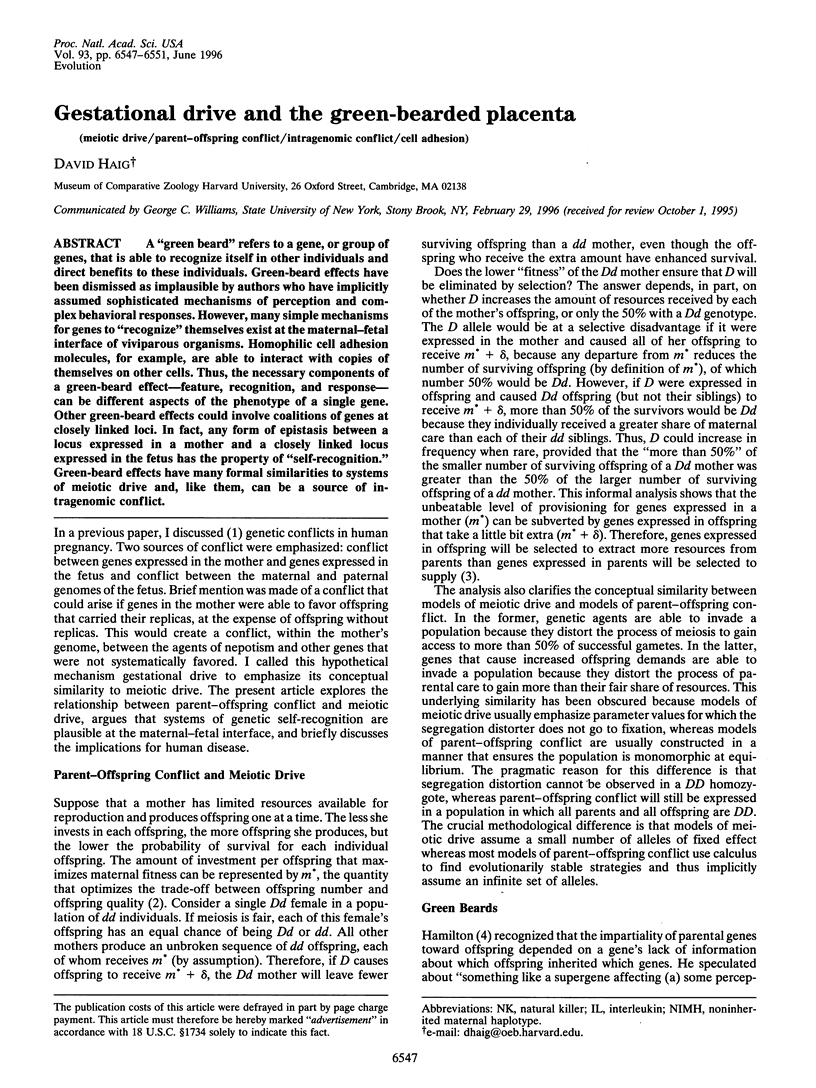
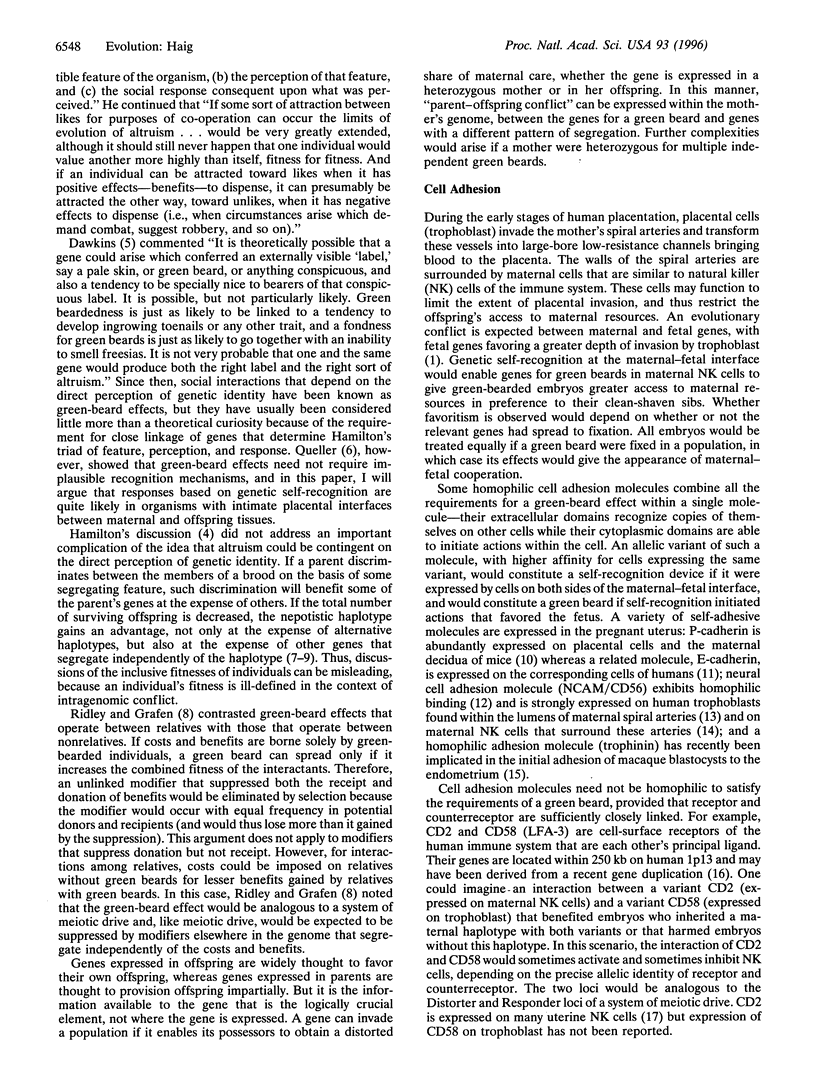
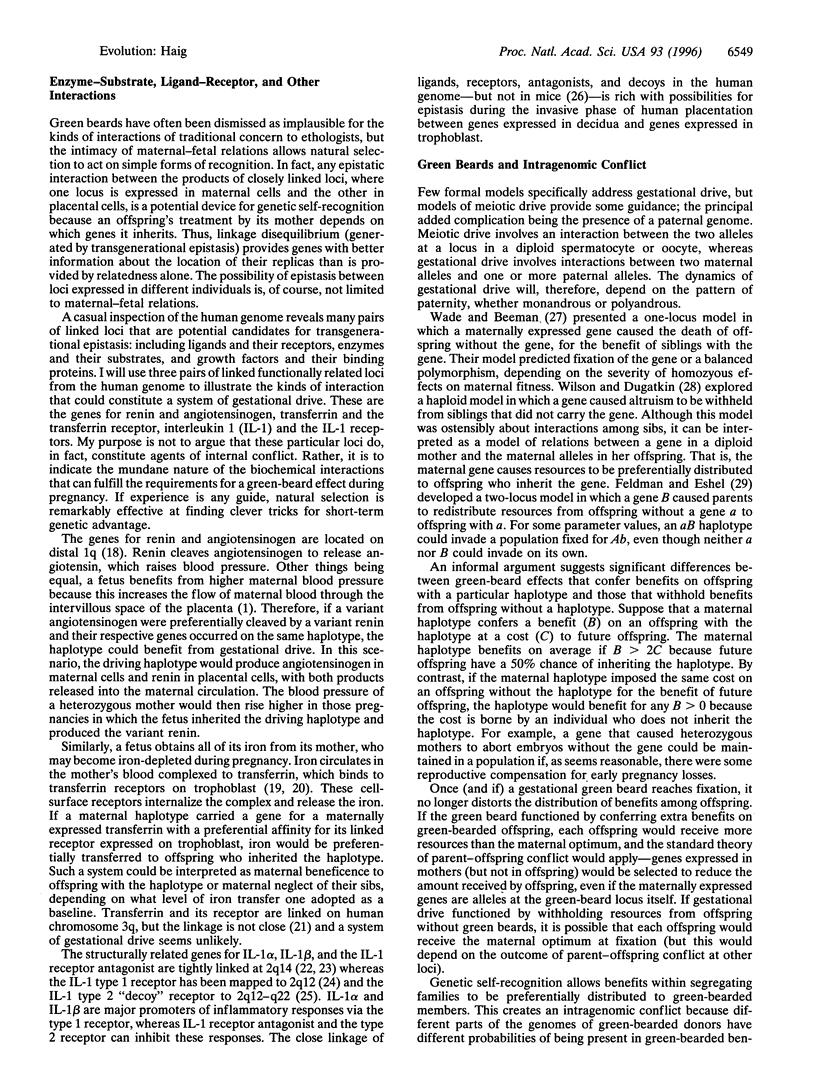
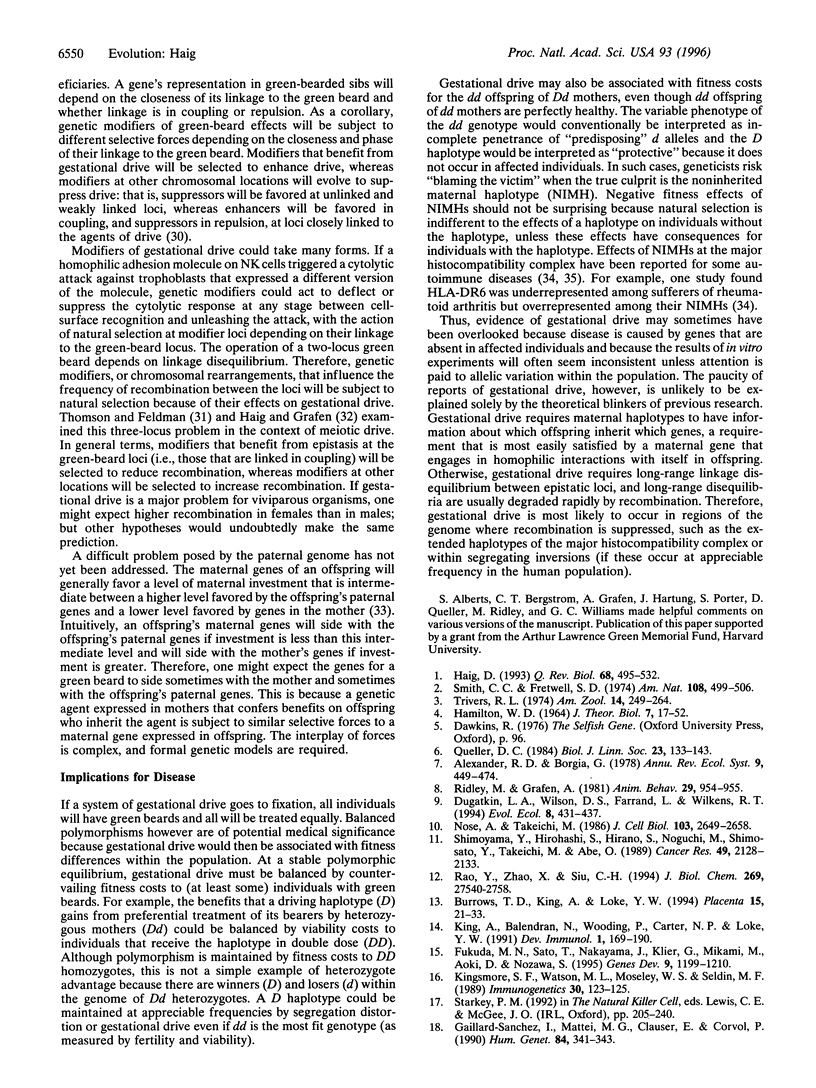
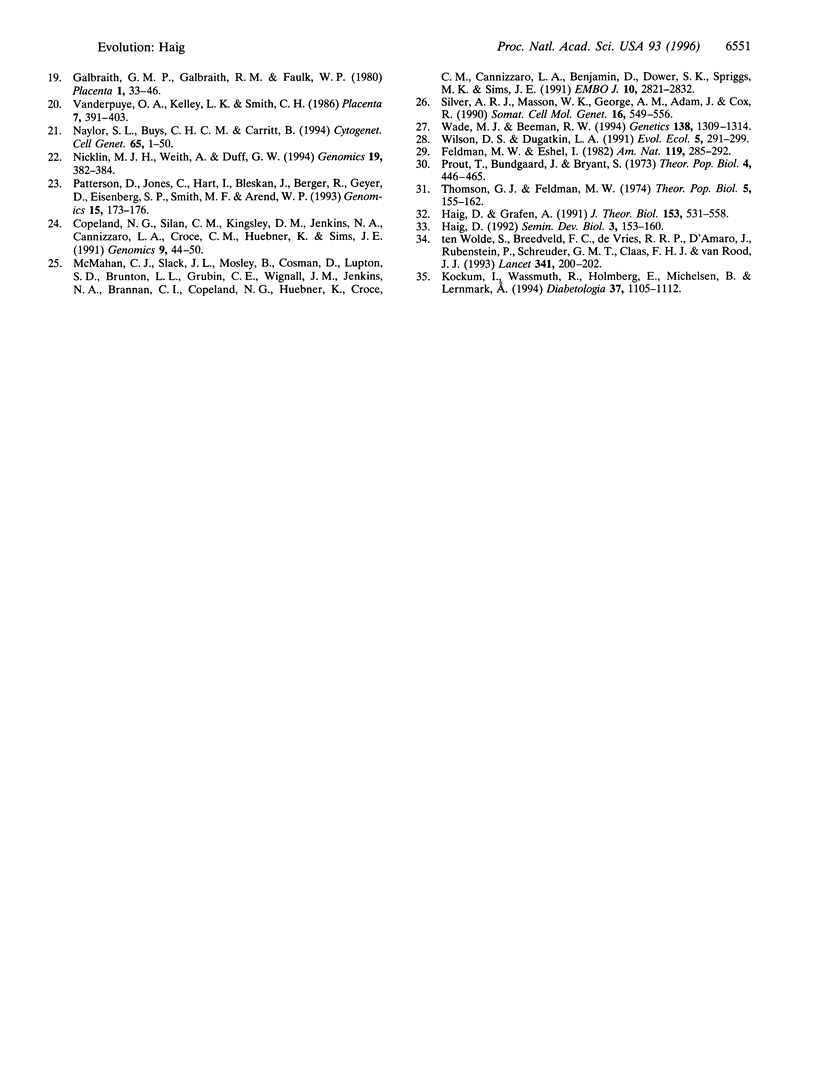
Selected References
These references are in PubMed. This may not be the complete list of references from this article.
- Burrows T. D., King A., Loke Y. W. Expression of adhesion molecules by endovascular trophoblast and decidual endothelial cells: implications for vascular invasion during implantation. Placenta. 1994 Jan;15(1):21–33. doi: 10.1016/s0143-4004(05)80233-4. [DOI] [PubMed] [Google Scholar]
- Copeland N. G., Silan C. M., Kingsley D. M., Jenkins N. A., Cannizzaro L. A., Croce C. M., Huebner K., Sims J. E. Chromosomal location of murine and human IL-1 receptor genes. Genomics. 1991 Jan;9(1):44–50. doi: 10.1016/0888-7543(91)90219-5. [DOI] [PubMed] [Google Scholar]
- Fukuda M. N., Sato T., Nakayama J., Klier G., Mikami M., Aoki D., Nozawa S. Trophinin and tastin, a novel cell adhesion molecule complex with potential involvement in embryo implantation. Genes Dev. 1995 May 15;9(10):1199–1210. doi: 10.1101/gad.9.10.1199. [DOI] [PubMed] [Google Scholar]
- Gaillard-Sanchez I., Mattei M. G., Clauser E., Corvol P. Assignment by in situ hybridization of the angiotensinogen gene to chromosome band 1q4, the same region as the human renin gene. Hum Genet. 1990 Mar;84(4):341–343. doi: 10.1007/BF00196230. [DOI] [PubMed] [Google Scholar]
- Galbraith G. M., Galbraith R. M., Faulk W. P. Immunological studies of transferrin and transferrin receptors of human placental trophoblast. Placenta. 1980 Jan-Mar;1(1):33–46. doi: 10.1016/s0143-4004(80)80014-2. [DOI] [PubMed] [Google Scholar]
- Haig D. Genetic conflicts in human pregnancy. Q Rev Biol. 1993 Dec;68(4):495–532. doi: 10.1086/418300. [DOI] [PubMed] [Google Scholar]
- Haig D., Grafen A. Genetic scrambling as a defence against meiotic drive. J Theor Biol. 1991 Dec 21;153(4):531–558. doi: 10.1016/s0022-5193(05)80155-9. [DOI] [PubMed] [Google Scholar]
- Hamilton W. D. The genetical evolution of social behaviour. II. J Theor Biol. 1964 Jul;7(1):17–52. doi: 10.1016/0022-5193(64)90039-6. [DOI] [PubMed] [Google Scholar]
- King A., Balendran N., Wooding P., Carter N. P., Loke Y. W. CD3- leukocytes present in the human uterus during early placentation: phenotypic and morphologic characterization of the CD56++ population. Dev Immunol. 1991;1(3):169–190. doi: 10.1155/1991/83493. [DOI] [PMC free article] [PubMed] [Google Scholar]
- Kingsmore S. F., Watson M. L., Moseley W. S., Seldin M. F. Physical linkage of genes encoding the lymphocyte adhesion molecules CD2 and its ligand LFA-3. Immunogenetics. 1989;30(2):123–125. doi: 10.1007/BF02421541. [DOI] [PubMed] [Google Scholar]
- Kockum I., Wassmuth R., Holmberg E., Michelsen B., Lernmark A. Inheritance of MHC class II genes in IDDM studied in population-based affected and control families. Diabetologia. 1994 Nov;37(11):1105–1112. doi: 10.1007/BF00418374. [DOI] [PubMed] [Google Scholar]
- McMahan C. J., Slack J. L., Mosley B., Cosman D., Lupton S. D., Brunton L. L., Grubin C. E., Wignall J. M., Jenkins N. A., Brannan C. I. A novel IL-1 receptor, cloned from B cells by mammalian expression, is expressed in many cell types. EMBO J. 1991 Oct;10(10):2821–2832. doi: 10.1002/j.1460-2075.1991.tb07831.x. [DOI] [PMC free article] [PubMed] [Google Scholar]
- Naylor S. L., Buys C. H., Carritt B. Report and abstracts of the Fourth International Workshop on Human Chromosome 3 Mapping. Cytogenet Cell Genet. 1994;65(1-2):2–50. [PubMed] [Google Scholar]
- Nicklin M. J., Weith A., Duff G. W. A physical map of the region encompassing the human interleukin-1 alpha, interleukin-1 beta, and interleukin-1 receptor antagonist genes. Genomics. 1994 Jan 15;19(2):382–384. doi: 10.1006/geno.1994.1076. [DOI] [PubMed] [Google Scholar]
- Nose A., Takeichi M. A novel cadherin cell adhesion molecule: its expression patterns associated with implantation and organogenesis of mouse embryos. J Cell Biol. 1986 Dec;103(6 Pt 2):2649–2658. doi: 10.1083/jcb.103.6.2649. [DOI] [PMC free article] [PubMed] [Google Scholar]
- Patterson D., Jones C., Hart I., Bleskan J., Berger R., Geyer D., Eisenberg S. P., Smith M. F., Jr, Arend W. P. The human interleukin-1 receptor antagonist (IL1RN) gene is located in the chromosome 2q14 region. Genomics. 1993 Jan;15(1):173–176. doi: 10.1006/geno.1993.1025. [DOI] [PubMed] [Google Scholar]
- Prout T., Bundgaard J., Bryant S. Population genetics of modifiers of meiotic drive. I. The solution of a special case and some general implications. Theor Popul Biol. 1973 Dec;4(4):446–465. doi: 10.1016/0040-5809(73)90020-8. [DOI] [PubMed] [Google Scholar]
- Rao Y., Zhao X., Siu C. H. Mechanism of homophilic binding mediated by the neural cell adhesion molecule NCAM. Evidence for isologous interaction. J Biol Chem. 1994 Nov 4;269(44):27540–27548. [PubMed] [Google Scholar]
- Shimoyama Y., Hirohashi S., Hirano S., Noguchi M., Shimosato Y., Takeichi M., Abe O. Cadherin cell-adhesion molecules in human epithelial tissues and carcinomas. Cancer Res. 1989 Apr 15;49(8):2128–2133. [PubMed] [Google Scholar]
- Silver A. R., Masson W. K., George A. M., Adam J., Cox R. The IL-1 alpha and beta genes are closely linked (less than 70 kb) on mouse chromosome 2. Somat Cell Mol Genet. 1990 Nov;16(6):549–556. doi: 10.1007/BF01233095. [DOI] [PubMed] [Google Scholar]
- Thomson G. J., Feldman M. W. Population genetics of modifiers of meiotic drive. II. Linkage modification in the segregation distortion system. Theor Popul Biol. 1974 Apr;5(2):155–162. doi: 10.1016/0040-5809(74)90038-0. [DOI] [PubMed] [Google Scholar]
- Vanderpuye O. A., Kelley L. K., Smith C. H. Transferrin receptors in the basal plasma membrane of the human placental syncytiotrophoblast. Placenta. 1986 Sep-Oct;7(5):391–403. doi: 10.1016/s0143-4004(86)80027-3. [DOI] [PubMed] [Google Scholar]
- Wade M. J., Beeman R. W. The population dynamics of maternal-effect selfish genes. Genetics. 1994 Dec;138(4):1309–1314. doi: 10.1093/genetics/138.4.1309. [DOI] [PMC free article] [PubMed] [Google Scholar]
- ten Wolde S., Breedveld F. C., de Vries R. R., D'Amaro J., Rubenstein P., Schreuder G. M., Claas F. H., van Rood J. J. Influence of non-inherited maternal HLA antigens on occurrence of rheumatoid arthritis. Lancet. 1993 Jan 23;341(8839):200–202. doi: 10.1016/0140-6736(93)90065-o. [DOI] [PubMed] [Google Scholar]


